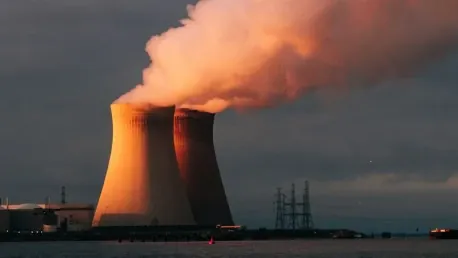China, the world’s largest emitter of greenhouse gases, continues to face substantial challenges in meeting its emission reduction goals. Recent approval for the construction of 11 new nuclear reactors across five sites marks a significant advancement in China’s efforts to combat climate change and transition to sustainable energy sources. This move, spearheaded by Premier Li Qiang during a State Council executive meeting, represents a pivotal step in reducing the country’s dependency on coal-fired power plants. The urgency of these actions is underscored by the nation’s commitment to peak its carbon emissions between 2026 and 2030 and achieve carbon neutrality by 2060. As China grapples with the complexities of such a monumental shift, the implementation of these new reactors signals a strong intention to lead the way in global environmental stewardship.
Approval of New Nuclear Reactors
The decision to approve these 11 new nuclear reactors involves significant planning and investment, engaging three major players in China’s energy sector. The reactors will be built and operated by China National Nuclear Power, State Power Investment Corporation (SPIC), and China General Nuclear Power Corporation (CGN). Each of these entities has been entrusted with specific tasks and reactor projects, with CGN assuming the lion’s share by developing six reactors across three sites. Such a division of labor illustrates a coordinated effort within the industry to expedite the project efficiently and effectively. The total investment for constructing these reactors is projected to exceed 220 billion yuan, or about $30.8 billion, a figure that reflects China’s determination to overhaul its energy infrastructure.
This ambitious project demonstrates China’s determination to shift its energy mix away from fossil fuels toward lower-carbon options. Such a transition is crucial since the country aims to peak its carbon emissions within the next few years. The reactors are expected to take about five years to complete, which indicates a swift and strategic approach to enhancing the clean energy infrastructure of the nation. Given the sheer scale of investment and the aggressive timeline, the project also underscores the urgency with which China intends to address its environmental challenges while striving for economic stability.
Strategic Distribution Across Provinces
China’s strategic approach to the distribution of the new reactors considers geographic energy needs and potential. The new reactors will be dispersed across several provinces, including Jiangsu, Guangdong, Shandong, Zhejiang, and Guangxi, ensuring that the benefits and resources are equitably shared and efficiently utilized. This distribution is intended to harmonize regional energy demands with the broader national goal of reducing reliance on coal. The choice of these provinces is likely influenced by their existing industrial bases, energy consumption patterns, and availability of necessary infrastructure to support such large-scale projects.
As of now, China has 56 operational reactors contributing around five percent of its total electricity generation. With the addition of these new reactors, the country’s nuclear power capacity is poised for a significant boost. The new installations are expected to enhance the overall resilience and sustainability of China’s energy grid, making it less susceptible to the disruptions often associated with fossil fuel supply chains. With construction slated to take roughly five years, the initiative marks a decisive leap toward augmenting the share of nuclear power in China’s energy mix. The development not only aims at environmental benefits but also reflects on the foresight in ensuring energy security for the rapidly growing economy.
Economic and Environmental Impacts
The economic implications of this monumental plan are substantial, potentially revitalizing various sectors such as construction, technology, and energy. This influx of investment is likely to spur job creation, contributing to broader economic stability in the regions where these reactors are being built. Beyond just an infrastructural upgrade, promoting nuclear power underscores China’s commitment to achieving carbon neutrality by 2060. This commitment aligns with global environmental goals, positioning China as a front-runner in the battle against climate change. The calculated move to expand nuclear energy is aimed at curbing carbon emissions rapidly, providing a reliable and low-carbon energy alternative.
However, this progressive step is juxtaposed with China’s recent surge in approvals for coal-fired power plants, raising concerns about its consistency in environmental commitments. The dual approach of promoting nuclear while expanding coal power complicates China’s environmental narrative. The balance of economic growth with sustainable practices remains a critical challenge. The simultaneous development of nuclear and coal-fired plants highlights the difficulty in transitioning entirely to sustainable energy sources without destabilizing the current energy framework. This strategic duality may jeopardize China’s long-term environmental goals if not carefully managed, underscoring the complexity of enacting effective energy policy on such a massive scale.
Comparisons with Global Nuclear Trends
China’s strategic blueprint for the deployment of new reactors takes into account geographic energy demands and feasible potentials. The reactors will be spread across provinces such as Jiangsu, Guangdong, Shandong, Zhejiang, and Guangxi. This planned distribution ensures that the benefits and resources are balanced and utilized efficiently. The aim is to align regional energy demands with the national goal of reducing coal dependency. The choice of provinces is likely influenced by their industrial bases, energy usage patterns, and the availability of infrastructure needed for such significant projects.
Currently, China operates 56 reactors, generating about five percent of its total electricity. The new reactors will substantially increase nuclear power capacity. These installations are expected to bolster the resilience and sustainability of China’s energy grid, reducing vulnerability to disruptions common in fossil fuel supply chains. With an estimated construction timeline of five years, this initiative marks a critical step toward increasing the proportion of nuclear power in China’s energy portfolio. The project underscores environmental benefits and reflects strategic foresight to ensure energy security for China’s rapidly expanding economy.









